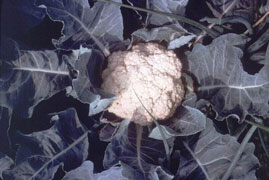


Home
Flowers &
Indoor Plants
Fruits & Nuts
Ornamentals
Vegetables
Special Topics
Resources
Glossary

|
Cauliflower (Botrytis Group) Brassica oleracea (brass-ick-ah ol-er-ay-see-ah) |
 |
What about it? Cauliflower is in the Mustard family with broccoli, cabbage, and Brussels sprouts. It is the most demanding member of this family. What is it used for? The pre-flowering head, or curd, is edible. Where does it grow? How do we grow it? Cauliflower is very similar to broccoli in its growing requirements. However, cauliflower needs to be grown in the cool season; either early spring or late summer/fall. When the head begins to develop, you need to wrap the outer leaves over the head to protect it from sunlight. This is called blanching. It requires cool temperatures, lots of water and soil with adequate drainage. What are its primary problems?The general cabbage pests will afflict the cauliflower as well. Look out for cabbageworms, cabbage loopers, aphids, and downy mildew. Be sure to check your plants daily for any pests. Wet weather could invite insects or disease. Clubroot can stunt growth and cause wilting. How do we propagate it? Sow seeds indoors 6 weeks before the last frost. Plant transplants 12 inches apart in rows 28 inches apart. How do we harvest and store it? Cut the stalk, just below the curd, when the cauliflower is fairly large and has a smooth surface. Don't wait too long though - the curds will separate and look like grains of rice. Store in a very cool place with high humidity.
© Copyright, Department of Horticulture, Cornell University. |